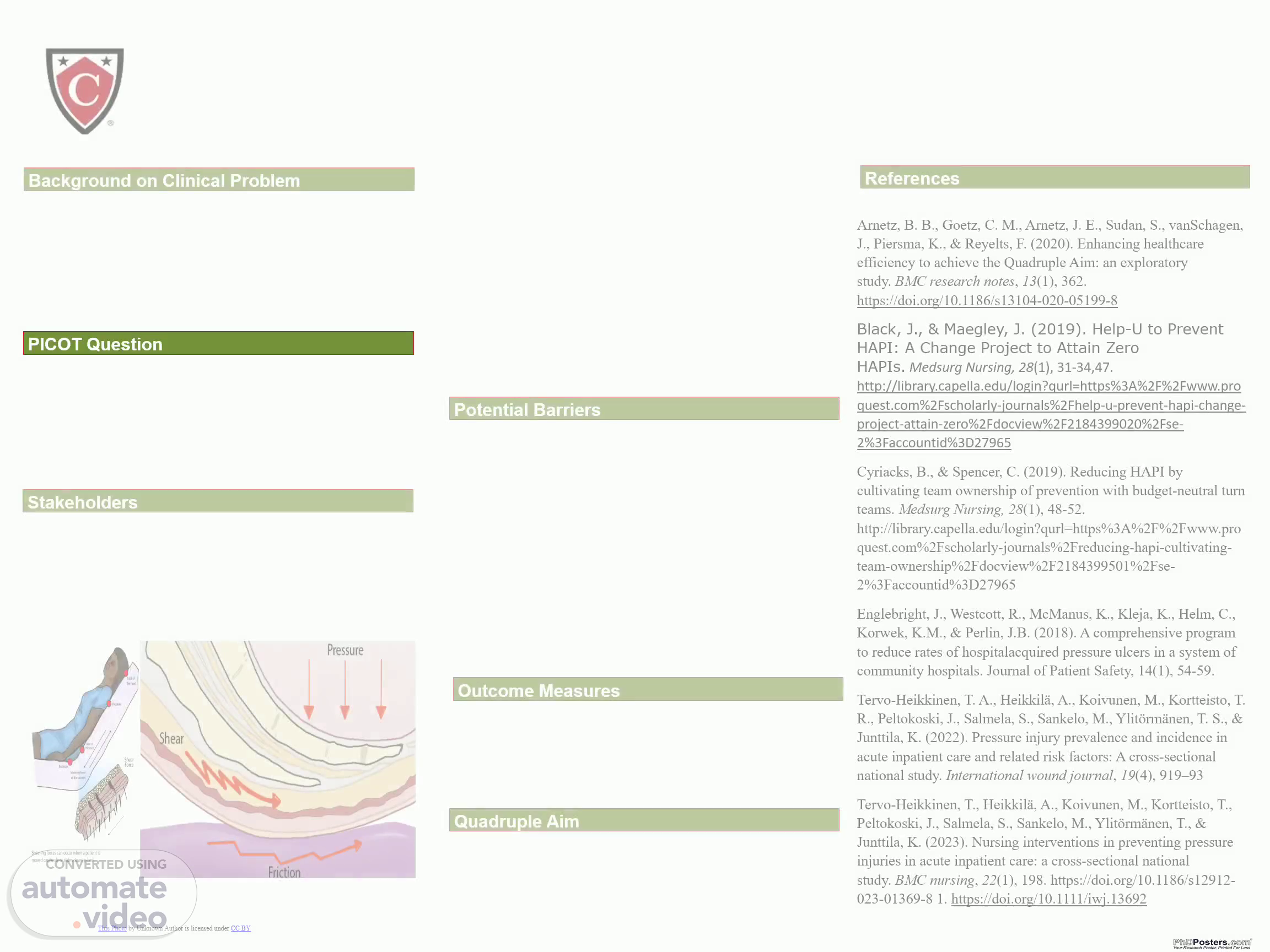
Page 1 (0s)
[Audio] Pressure ulcers and injuries are common occurrences that are generally avoidable in an inpatient setting. Medical patients with older age groups, incapacity to move independently, method of arrival, and no skin examination or pressure injury risk assessment at admission had a higher risk of hospital-acquired pressure injuries (Tervo-Heikkinen, 2022). Hospital-acquired pressure injuries on two medical-surgical units were identified as financial and patient outcome concerns (Black, 2019). There is currently a process in place for repositioning the patient every two hours, but it is not always performed. PICOT questions are the following; In adult inpatients (P), does the implementation of a comprehensive pressure injury prevention program by nurses (I), compared to standard pressure injury prevention practices (C), result in a reduction in the occurrence of pressure injuries (O) during the hospital stay (T)? Stakeholders include inpatient Nurse, patient care tech, physicians, wound care nurse, charge nurse/ floor managers. Nurses play a major role in hospital acquired pressure injury prevention as an indicator for quality nursing care. Action plans would include skin inspection within 8 hours upon admission, every time there is a change in condition, and prior to discharge from the hospital, the Braden risk scoring tool would be utilized for every shift change, daily auditing documentation of patient repositioning, yearly hospital acquired pressure injury education for nurses and CNAs, assessing malnutrition within a week of admission. The suggested action plans are logical and achievable because they are consistent with recognized best practices for enhancing patient safety, reducing problems, and delivering adequate treatment. They promote early detection, prompt action, education, and preventative measures to enhance patient outcomes and treatment quality. Potential Barriers and how to mitigate them include resistance to change. To mitigate this, engage stakeholders early in the process and address concerns. The second is a lack of clear expectations. To mitigate this, the administration should set clear goals and objectives. The third is a lack of resources. To mitigate this, assess resources and identify any gaps and limitations. The fourth is a lack of communication. To solve this, provide regular updates. Lastly, is the misunderstanding of the evidence related to pressure injuries. The organization can provide continuing education and training to resolve this. Outcome Measures: Current pressure injury data is 5 hospital acquired pressure injury cases per 1,000 patient days. Hospital acquired pressure injury cases down to three in one month. Hospital acquired pressure injury cases are down to 2 in 3 months. Hospital acquired pressure injury cases down to 1 case at 6 months. The outcome measurements motivate team members to offer high-quality treatment and a great patient experience. While a productivity emphasis needs outputs and puts pressure on stakeholders to produce results, an efficiency focus deals with modification of processes and necessitates organizational transformation. Thus, ideally, a focus on efficiency should enable staff to accomplish performance metrics while boosting workplace well-being since resources and procedures are more efficient, and team members are working at the top of their abilities. For the Quadruple Aim, patient experience improved, population health improved, healthcare costs were reduced, and health care provider work lives were evaluated and improved. Hospital-acquired pressure injuries affect 1 in 30 patients and cause 60,000 fatalities annually (Englebright et al., 2018). In conclusion,.